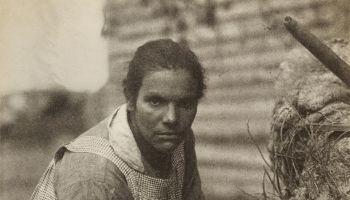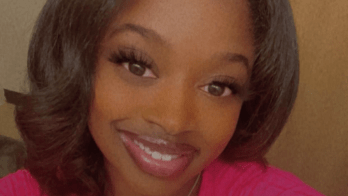WARNING: GRAPHIC PHOTOS
Images matter. Just like albums, books, and Black lives, as Prince once so eloquently said.
But when we talk about images and image activism, we mostly speak about perpetuating “positive” images — brown girls and women who are complex, accomplished and fierce, or Black men who run the free world with daughters who run free.
’Tis true, those images matter, shaping our minds of those of our children, showing us and them what is possible. But what of the converse? What about those images that feed us a constant diet of death, violence, and destruction?
Those images matter too. It’s why most conscientious parents try to limit their children from playing violent video games, consuming R rated movies or even watching the news.
And this is why The New York Daily News was dead wrong in placing the gruesome image of Alton Sterling on its cover Thursday. The still of his dead body splayed on the concrete, blood covering his chest, eyes rolled in the back of his head while a Baton Rouge, Louisiana, police officer rolled on the ground next to him with his gun drawn like a scene from T.J. Hooker, was both disgusting and unconscionable.
https://twitter.com/NYDailyNews/status/751020959344320512
Here’s why:
1. It’s Exploitative
In 1955, when Mamie Till chose to place the image of her son’s bloated, desecrated body in an open casket in Jet magazine for all the world to see, she was making a statement. As his mother, she wanted to show the world what those vicious, cowardly bastards did to her child that summer in Mississippi. Mamie Till, had, as we say, skin in the game. Skin and sinew and bone and blood. The Daily News has no such claim. Ostensibly, the News’ reasoning for such a graphic cover was to “shock” America into consciousness. But really? Or was it to generate controversy, sell papers, and pat itself on the back for being cutting edge in the gun debate in general, and the killing of Black men at the hands of police specifically?
Philando Castile’s girlfriend, Diamond “Lavish” Reynolds, who live streamed his death on Facebook Live, had skin in the game. She may have been putting her own life, and that of her daughter, in danger by videoing her boyfriend’s death in real-time in front of her 4-year-old. Mamie Till lost her son, Emmett Till, who was tortured by demons far, far, away from where she was. Lezley McSpadden, Michael Brown’s mother, wrote the following in The New York Times the same day the cover dropped: “Death isn’t pretty for anyone, but what these families now face is the horror of seeing their loved one die over and over, in public, in such a violent way.”
You may say that a death image is a death image, but where it comes from is important. Exploitation is nothing new, but it’s still wrong. And when you have no skin in the game, most likely you’re being exploitative.
2. It’s Racialized
I simply don’t believe the News would have published a photo of a dead White person on its cover. The Daily News has in the recent past done “provocative” covers around issues of gun violence. In August last year, it ran an image showing the seconds before reporter Alison Parker was murdered on camera. And yet, they didn’t show her lying dead in the street. Why is that? Though that cover was criticized by some, it pales in comparison to Sterling’s. Do you think for one moment that The News would have shown the dead bodies of even one of the police officers killed on Thursday? Or since it’s Dallas, the gruesome image of President Kennedy after his assassination? Or the precious children from Sandy Hook? And why didn’t newspapers show the images of people jumping from buildings after 9/11?
Racial disparity—evident in everything from how Black people are treated when openly carrying weapons, to the NRA’s silence on the fact that Philando Castile was a legal gun owner, is evident in every aspect of American life. The press is no different. The distance that Whites can have in viewing Sterling’s body —being “spectators to Black suffering” — is something that we African-Americans do not have. The same respect they would have given any one of those other people aforementioned should be afforded to Sterling and his family.
3. This cover was not FOR us
As of Sunday, the Daily News’ editors have not commented on the cover — but most likely the paper felt that its White readers needed something jarring to understand just how dire the situation between African Americans and law enforcement is. Those who felt that the cover was necessary, including some writers whom I respect immensely, and even my husband, say that this image is the “wake up” call the country needs. It will make folks do something, they say, in the tradition of Ida B. Wells and her documentation of lynching; surely, it will stir the country’s (i.e., White folks’) conscience. Because they haven’t really cared heretofore. Black folk been knowing that this was going on, and that line of thinking just goes to prove that that cover is not for us, but uses us to make the point.
Ever notice how every fraught issue in this country is played out on Black bodies? Sexual harassment had a face in Anita Hill. Police brutality in Rodney King. The Confederate flag in nine murdered parishoners in a Charleston, South Carolina, church. And now, police violence comes to a head with a dead Alton Sterling for all the world to see. Our bodies are not canvases for the fraught topics du jour and for some to see our humanity.
4. Trauma
Trigger warning or no, when Black women, children, and men see Alton Sterling, they see themselves, their uncles, their brothers, their sons. We as Black folk cannot separate ourselves, even our very existence, from these horrific images. There were no words for the helpless, tired, hang-wringing anger and devastation that I and every single Black person I know felt on Thursday — from the educated to those in the ‘hood, from the young to the “seasoned.” What defines “Blackness in America” you ask? THIS. This is the common denominator that binds all Black folk in this country – our treatment — and the very precariousness of our lives. Many of us wept, many of us were numb, most of us were angry and afraid for our children. But all of us were broken just a little bit from this back-to-back senseless destruction of these men, dead for no good reason.
Since the Black Lives Matter movement has gained momentum, there has also been lots of talk about self-care and protecting one’s mental health. People say turn off the news, don’t watch the videos, take a “social media break.” We need respite from the slow, insidious terrorism that has been inflicted upon us — yes, the actual terror on Black bodies, for sure, but also the constant stream of “high tech lynchings” documenting this terror. Snuff films are illegal, so why should we have to see Black folks killed in primetime, all the time?
A good friend of mine calls these images and videos “Black death porn.” And just like porn-porn, constant exposure to these images desensitizes you. It makes Black death routine, mundane and business as usual. So what the Daily News totally missed was that publishing this picture was just more trauma on top of the real life trauma of this man being brutally killed in the street, shot in the chest for no reason.
I shouldn’t have to walk on a subway platform on the way to work and see a dead Alton Sterling lying on the ground. These images are modern-day lynchings, as heavy as pictures of Black men hanging from trees — a constant reminder of Black death, and warning us of our fragility and “place.”
Last question: What happens when those cops who killed Alton Sterling get off? What’s next? If dead children being slaughtered in school, 49 people getting murdered in a club, and how many hundreds more killed in the latest mass shooting didn’t change anything, will this image? Perhaps consuming all this death makes me cynical (or perhaps I’m a realist).
The only thing that that front page did was traumatize Black mothers, make White supremacists rejoice, and sell more papers. In my mind, publishing this photo is reinforcing the fact that Black lives don’t matter. The road to hell is paved with good intentions, and the hell of this black death porn is just one more heartbreak on top of many.
To them it’s an issue. For us, it’s life.
Angela Bronner Helm is a writer, editor and adjunct professor of journalism at City College. She luuuuuuhs life, most people, good food and travel. Not a respectability politics kinda girl. Follow her on Twitter and Instagram.
PHOTO CREDIT: Getty, Twitter















